Papers by CHAVES, H . A . F.
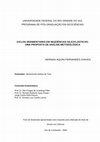
Ph Tesis GRAD. PROG.IN GEOSCIENCES. - FED. UNIV. OF R. GRANDE DO SUL , 2000
This paper applies quantitative stratigraphy to understand the pattern of coarse clastic sediment... more This paper applies quantitative stratigraphy to understand the pattern of coarse clastic sedimentary rocks. Sedimentary cycles in siliciclastic sequences can be detected and analyzed using a gamma-ray log to provide a series of measures associated with bed thickness. The variation in bed thickness gives a perfect identification of parasequences and their internal geometry on upward thickening or thinning, allowing the accurate identification of the sedimentary environment, facies, and system tracts in a sequence stratigraphy context. The pile-up pattern can then be analyzed using time series methods, like time scattergram (XY plots), Fischer plots, auto- and cross-correlation, and spectral analysis. The ratios among the various periods of the sedimentary cycles can be compared and associated with astronomical cycles in the band of Milankovitch, allowing the estimation of deposition time and accumulation rates. Besides, the results give an
excellent insight into the sedimentary processes of filling the sedimentary basin, sea level variation, and sedimentary flux. Using this analysis method, it is possible to identify fourth and fifth-order sequences (in the Exxon sense) that can be correlated locally. This application of quantitative stratigraphy allows for the correlation of third-order sequences. It may provide a way to compare locally identified sea level oscillation with the proposed global sea level variation curves. This methodology was developed by the LABCG - Laboratory of Basin Analysis and Geological Correlation - of the Faculty of Geology of UERJ - the University of the State of Rio Janeiro. As an illustration, examples of application are discussed for the Permian of the Parana Basin and the Barremian section of the Reconcavo Basin
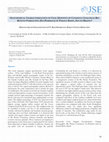
Journal of Sedimentary Environments, 2018
This work analyses organic geochemistry (total organic carbon - TOC, total Sulphur - S and Rock E... more This work analyses organic geochemistry (total organic carbon - TOC, total Sulphur - S and Rock Eval pyrolysis data) and detailed organic petrography results of the Eo-Permian interval (Rio Bonito Formation, Paraná Basin) in the Grande Candiota area, Rio Grande do Sul State (RS), where the largest Brazilian coalfield is located. Samples were collected along the SVH-07 well and in front of the open-pit mine at Seival. The organic petrography analysis allowed to characterize the coals composition and to classify the stage of coalification. The results reveal that the Grande Candiota coals were deposited in a stormy coastal environment. As the samples present high percentage of inorganic material, the Seival coals must be considered more appropriately as coaly shales. The highest percentage of TOC was observed at the base of the coal Seams. The Upper Seam 7(US7) presents the highest average organic matter content and the Lower Candiota Seam (LCS) the lowest one. The sampled coals can b...

Anais Da Academia Brasileira De Ciencias, 1998
In the Brazilian territory. the gondwanic coal (Kungurian. Early Permian) of the Parana Basin. ex... more In the Brazilian territory. the gondwanic coal (Kungurian. Early Permian) of the Parana Basin. extends in a discontinuous belt parallel to the eastern margin of the basin. from the Rio Grande do Sul to the Sao Paulo state. Most of the coal beds are in the Siderópolis Member of the Rio Bonito Formation. in a barrier-bar lagoon setting. as seen in the Criciuma area, Santa Catarina state; others are in the deltaic section of the Triunfo Member. at the base of the same formation. In the Criciuma area. detailed stratigraphic sections were prepared. with the datum chosen in a stratigraphic marker bed above the last coal bed. near the transition Rio Bonilo-Palermo formations. These sections show undulating geometries affecting the coal beds. These beds are supposed to be continuous as a result of deposition in a single lagoon where favorable conditions for coal development were attained. At the same time. sand bodies assumed to be the depositional barrier-bar counterparts of the lagoon, change their thickness across the belt. The only plausible explanation for this configuration is the presence of growth faults acting during deposition, as shown in modern examples of the Niger Delta, which presents barrier bar-lagoon settings. The same is reported in the Figueira area, Parana state, where the coal beds are situated in the basal member of the Rio Boni10 Formation. In this area, coal is associated wilh deltaic sediments and growth faults. with the characteristic low angle planes, are seen everywhere along an open-pit mine. Growth faults are adiastrophic in nature. being mostly due to the sand overload by fluvial-dominated delta deposition or by sandstone lobes exhibiting hummocky cross-stratification in barrier bars formed by storm-related processes after marine transgressions in storm-wave-dominated deltas.

Anais da Academia Brasileira de Ciências, 1998
In the Brazilian territory. the gondwanic coal (Kungurian. Early Permian) of the Parana Basin. ex... more In the Brazilian territory. the gondwanic coal (Kungurian. Early Permian) of the Parana Basin. extends in a discontinuous belt parallel to the eastern margin of the basin. from the Rio Grande do Sul to the Sao Paulo state. Most of the coal beds are in the Siderópolis Member of the Rio Bonito Formation. in a barrier-bar lagoon setting. as seen in the Criciuma area, Santa Catarina state; others are in the deltaic section of the Triunfo Member. at the base of the same formation. In the Criciuma area. detailed stratigraphic sections were prepared. with the datum chosen in a stratigraphic marker bed above the last coal bed. near the transition Rio Bonilo-Palermo formations. These sections show undulating geometries affecting the coal beds. These beds are supposed to be continuous as a result of deposition in a single lagoon where favorable conditions for coal development were attained. At the same time. sand bodies assumed to be the depositional barrier-bar counterparts of the lagoon, change their thickness across the belt. The only plausible explanation for this configuration is the presence of growth faults acting during deposition, as shown in modern examples of the Niger Delta, which presents barrier bar-lagoon settings. The same is reported in the Figueira area, Parana state, where the coal beds are situated in the basal member of the Rio Boni10 Formation. In this area, coal is associated wilh deltaic sediments and growth faults. with the characteristic low angle planes, are seen everywhere along an open-pit mine. Growth faults are adiastrophic in nature. being mostly due to the sand overload by fluvial-dominated delta deposition or by sandstone lobes exhibiting hummocky cross-stratification in barrier bars formed by storm-related processes after marine transgressions in storm-wave-dominated deltas.

In the Brazilian 1erritor). the gond\1-anic coal (Kungurian. Early Pem1ian) of the Paran.i Basin.... more In the Brazilian 1erritor). the gond\1-anic coal (Kungurian. Early Pem1ian) of the Paran.i Basin. extends in a discontinuous belt parallel to the eastern margin of the basin. from 1he Rio Grande do Sul to the Sao Paulo state. Most of 1he coal beds arc in the Sider6polts Member of the Rio Bonito Forma1t0n. in a bamer-bar lagoon selling. as seen in the Cnc111ma area. Santa Catarina state; others arc in 1hc deltaic section of the Triunfo Member. at the base of the same forma1ion. In the Criciuma area. detailed stratigraphic sections were prepared. with the datum chosen in a stratigraphic marker bed above the las1 coal bed. near the transition Rio Bonilo-Palermo fonnations. These sections show undulating geome1ries affecting the coal beds. These beds are supposed to be continuous as a result of deposition in a ,ingle lagoon where favorable conditions for coal development were auained. At the same Lime. sand bodies. ,Lssumed to be the depositional barrier-bar counterparts of the lagoon, change their thickness across the belt. The only plausible explanation for this configuration is the presence of growthfaults acting during deposition, as shown in modern examples of Niger delta, which presents barrier bar-lagoon settings. The same is reported in the Figueira area, Parana state, where the coal beds are situa1ed in the basal member of the Rio Boni10 Fom,ation. In this area, coal is associa1ed wilh deltaic sedimenls and grow1h faults. with the characteristic low angles planes, are seen everywhere along an open-pit mine. Growth-faults are adiastrophic in nature. being mostly due to the sand overload by nuvial-dominated delta deposition or by sandstone lobes exhibiting hummocky cross stratification in barrier bars formed by stormrelated processes after marine transgressions in storm-wave-dominated deltas.
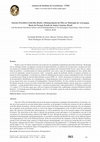
Anuário do Instituto de Geociências - UFRJ
Desde os anos 50 a Bacia do Paraná vem sendo alvo de campanhas exploratórias para hidrocarbonetos... more Desde os anos 50 a Bacia do Paraná vem sendo alvo de campanhas exploratórias para hidrocarbonetos. Há décadas tem se realizado estudos, em algumas ocorrências de hidrocarbonetos, na tentativa de correlacionar a existência de óleos em arenitos da Formação Rio Bonito, às possíveis rochas geradoras das formações Ponta Grossa e Irati. Para as companhias de petróleo, o reconhecimento do sistema petrolífero, bem como o grau de biodegradação do óleo, afetam tanto na fase de exploração, seleção de possíveis “play” e prospecto, quanto de produção, devido ao impacto econômico no projeto de óleos degradados. A motivação no estudo de identificação da origem e grau de degradação de óleo, foi devido a ocorrência uma coluna de 26m de hidrocarboneto no poço MML-38. Através da presença ou ausência de um conjunto de biomarcadores identificados em cromatogramas e fragmentogramas torna-se possível a interpretação e identificação de sua origem bem como seus graus de biodegradação e Sistema Petrolífero. ...
Viii Cng 2010, Jun 26, 2010
A teoria da microeconomia trata do comportamento das firmas e dos individuos ou familias, preocup... more A teoria da microeconomia trata do comportamento das firmas e dos individuos ou familias, preocupando-se com a formacao dos precos e o funcionamento do mercado de cada produto individual. Estuda, por exemplo, as decisoes de uma fabrica de quantos trabalhadores contratar, quanto produzir, a que preco vender, etc. No caso do petroleo, e aplicada no estudo da demanda, da oferta e da inelasticidade dos precos. A experiencia recente demonstra uma inelasticidade da demanda-preco do petroleo.

Journal of Sedimentary Environments
This work studies the Buracica Stage (Barremian, Early Cretaceous) in the Recôncavo Basin, Bahia ... more This work studies the Buracica Stage (Barremian, Early Cretaceous) in the Recôncavo Basin, Bahia State (N.E. Brazil), comprising the São Sebastião and Pojuca formations, from the analysis of 143 well logs and outcrop records. The Recôncavo Basin is a rift basin associated with the beginning of the South Atlantic Ocean. The basin started with very slow subsidence rates, leading to the formation of shallow lakes and the deposition of shales and sandstones, which compose the Brotas Group; later, subsidence accelerated and gave rise to the formation of a deep lake. Then the deep lake basin was filled throughout six depositional episodes making up the so-called Recôncavo tectonic sequence. Previous studies divided the last depositional event of Recôncavo Basin into seven fourth-order sequences concerning the Marker Bed "1" to the Marker Bed "F" stratigraphic interval. Sequence boundaries were marked by sharp flooding surfaces related to the transgression of lacustrine system due to rapid tectonic subsidence and generation of accommodation. In turn, the sequences are divided into three systems tracts: the lake lowstand systems tract, the transgressive systems tract and the lake highstand systems tract. The maximum flood surface of the sequences generally coincides with the stratigraphic marker "B" to "F". Depositional systems like braided-fluvial plus eolian dunes, meandering-fluvial, deltaic, or moving-lake and near-shore deposits were identified in this work. Isopach, isolith and sand percentage maps indicate depocentre and source area distribution like the previous Aratu Stage. The primary sources of the sediments are located in the west and north areas; only from the third sequence, an eastern source could be described conspicuously. The fourth-order cyclicity is controlled by lake level changes, related to climatic factors (Milankovitch cycles). The results from the studies of cyclicity confirm the proposed stratigraphic model. They indicate 43,000 years for each fourth-order sequence and 150,000 years for the third-order sequences, which provide an accumulation rate of 1200 mm per 1000 years for the studied interval.

Characteristic analysis is well known in mineral resources appraisal and has proved useful for ... more Characteristic analysis is well known in mineral resources appraisal and has proved useful for petroleum exploration. It also can be used to integrate geological data in sedimentary basin analysis and hydrocarbon assessment, considering geological relationships and uncertainties that result from lack of basic geological knowledge, A generalization of characteristic analysis, using fuzzy—set theory and fuzzy logic, may prove better for quantification of geologic analogues and also for description of reservoir and sedimentary facies. Characteristic analysis is a discrete multivariate procedure for combining and interpreting data; Botbol (1971) originally proposed its application to geology, geochemistry, and geophysics. It has been applied mainly in the search for poorly exposed or concealed mineral deposits by exploring joint occurrences or absences of mineralogical, lithological, and structural attributes (McCammon et al., 1981). It forms part of a systematic approach to resource appraisal and integration of generalized and specific geological knowledge (Chaves, 1988, 1989; Chaves and Lewis, 1989). The technique usually requires some form of discrete sampling to be applicable—generally a spatial discretization of maps into cells or regular grids (Melo, 1988). Characteristic analysis attempts to determine the joint occurrences of various attributes that are favorable for, related to, or indicative of the occurrence of the desired phenomenon or target. In geological applications, the target usually is an economic accumulation of energy or mineral resources. Applying characteristic analysis requires the following steps: 1) the studied area is sampled using a regular square or rectangular grid of cells; 2) in each cell the favorabilities of the variables are expressed in binary or ternary form; 3) a model is chosen that indicates the cells that include the target (Sinding—Larsen et al, 1979); and 4) a combined favorability map of the area is produced that points out possible new targets. The favorability of individual variables is expressed either in binary form— assigning a value of +1 to favorable and a value of 0 to unfavorable or unevaluated variables—or in ternary form if the two states represented by 0 are distinguishable—the value +1 again means favorable, the value—1 means unfavorable, and the value 0 means unevaluated.
Keywords: Boolean algebra, characteristic analysis, drainage form, eigenvector analysis, faults, gridded data, inhomogeneity, oil exploration, petroleum, regional evaluation
Journal of Sedimentary Environments, Mar 19, 2018
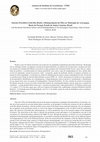
Anuário do Instituto de Geociências - UFRJ
Desde os anos 50 a Bacia do Paraná vem sendo alvo de campanhas exploratórias para hidrocarbonetos... more Desde os anos 50 a Bacia do Paraná vem sendo alvo de campanhas exploratórias para hidrocarbonetos. Há décadas tem se realizado estudos, em algumas ocorrências de hidrocarbonetos, na tentativa de correlacionar a existência de óleos em arenitos da Formação Rio Bonito, às possíveis rochas geradoras das formações Ponta Grossa e Irati. Para as companhias de petróleo, o reconhecimento do sistema petrolífero, bem como o grau de biodegradação do óleo, afetam tanto na fase de exploração, seleção de possíveis “play” e prospecto, quanto de produção, devido ao impacto econômico no projeto de óleos degradados. A motivação no estudo de identificação da origem e grau de degradação de óleo, foi devido a ocorrência uma coluna de 26m de hidrocarboneto no poço MML-38. Através da presença ou ausência de um conjunto de biomarcadores identificados em cromatogramas e fragmentogramas torna-se possível a interpretação e identificação de sua origem bem como seus graus de biodegradação e Sistema Petrolífero. ...

Journal of Petroleum Exploration and Production Technology
This assessment of the volumetric potential of the oil shales of Tremembé Formation (Oligocene, T... more This assessment of the volumetric potential of the oil shales of Tremembé Formation (Oligocene, Taubaté Basin, Brazil) was based on the sedimentological study of 2457 total organic carbon and 1007 Rock–Eval pyrolysis analyses of core samples from nine survey wells drilled in the central portion of Taubaté Basin. Along a 240-m-thick package in the upper part of Tremembé Formation, thirteen chemostratigraphic units with thicknesses varying from 10 to 35 m were identified. The upper interval (unit L), 30 m thick, exhibited the highest organic content and original generation potential and was thus studied in detail. In unit L, oil yield maps were constructed, seeking to identify the most attractive areas for industrially exploiting the oil shales, and volumetric calculations employing a probabilistic Monte Carlo method were conducted to quantify the potentially recoverable oil volume. Three exploratory scenarios based on yield values (S1 + S2) were considered for calculating the oil vol...
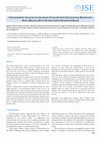
Journal of Sedimentary Environments
The section between the 7 and 11 electric markers in the Aratu Stage of the Recôncavo Basin (Lowe... more The section between the 7 and 11 electric markers in the Aratu Stage of the Recôncavo Basin (Lower Cretaceous) has been studied in order to perform a stratigraphic analysis. This section bear reservoir rocks known as Imbé, Cambuqui and Miranga sandstones. It produces petroleum in fields like Miranga, Araçás, Taquipe, Miranga Norte and Imbé.The isopach map showed a general trend of increased subsidence for south and southeast. A series of structural lows surround the platform region known as Quiricó High. Southwestward, the Taquipe Canyon is an indication of the lake deepening in that region.In terms of depositional systems, it was interpreted that the Aratu Stage presented a river-dominated deltaic system all over its depositional history. In the proximal regions, located to the north and northwest, the main facies belong to the fluvial and delta plain associations and to the delta front and prodelta in the most distal system. The isolithic map and the sand percentage map indicates ...
Anuário do Instituto de Geociências - UFRJ
Resumo O presente artigo tem como intuito apresentar uma análise histórico-econômica das variaçõe... more Resumo O presente artigo tem como intuito apresentar uma análise histórico-econômica das variações observadas quanto aos valores de produção e consumo mundial de petróleo desde 1965 até 2015. Para a elaboração dessa análise foi utilizada a regressão linear, usando dados derivados do BP Statistical Review of World Energy 2016 e, posteriormente, foram construídos gráficos para os valores de produção e consumo. Com isso, são discutidos os dados obtidos, fazendo uma correlação com os fatores que vieram a influenciar essas variáveis, obtendo-se assim, uma melhor compreensão de seus comportamentos históricos.
Terrae Didatica
Neste estudo foi realizado um levantamento bibliográfico acerca da história da indústria petrolíf... more Neste estudo foi realizado um levantamento bibliográfico acerca da história da indústria petrolífera com o objetivo de construir uma melhor compreensão da indústria petrolífera desde seu surgimento, formação e posterior desenvolvimento. Além disso, procurou-se entender os possíveis fatores que a influenciam, tendo como exemplo, o preço do barril de petróleo, as reservas disponíveis e a geopolítica.

Estudo de Ciclos em Seqüências Siliciclásticas i Agradecimentos À Família, razão primeira de todo... more Estudo de Ciclos em Seqüências Siliciclásticas i Agradecimentos À Família, razão primeira de todo o esforço, o reconhecimento pelo estímulo, a compreensão e o apoio que nunca faltou. Com quarenta anos de profissão e mais de trinta buscando especializar-me em Geomatemática, é difícil diferenciar as idéias próprias das que vêm das leituras, discussões e palestras, que se transformaram pela experiência pessoal. De qualquer forma, nesse momento, é possível identificar algumas contribuições e, lamentavelmente, esquecer de mencionar outras. Companheiro de muito tempo, os últimos nove anos foram particularmente enriquecidos pelo convívio diário com o Prof. Jorge Carlos Della Fávera, que me estimulou às pesquisas em ciclicidade e ao embarque na aventura desta tese. Amigo e companheiro, o Prof. Rene Rodrigues sempre me estimulou a elaboração desta, e ainda teve a gentileza da sua leitura crítica. Aluno e amigo, o Geól. Marco André M. Medeiros participou do curso de especialização, no ano de 1992, tendo acompanhado todo o desenvolvimento das pesquisas em ciclicidade. Os professores Rui Alberto Azevedo dos Santos e Maria Antonieta Rodrigues me convidaram para participar da instalação do Laboratório de Análise de Bacias e Correlação Geológica, onde toda a pesquisa se desenvolveu Os alunos do Curso Projetos de Análise de Bacias (CPAB) (Especialização) acompanharam toda a evolução da pesquisa, juntamente com os bolsistas de Iniciação Científica e, particularmente, Lúcio, Glauco e Marcelo. A inscrição no doutorado da UFRGS foi possível, graças aos professores Margot
14th International Congress of the Brazilian Geophysical Society & EXPOGEF, Rio de Janeiro, Brazil, 3-6 August 2015, 2015
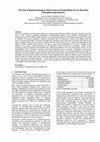
Given the importance and the growth potential of shrimpfarming activities in Brazil, this paper a... more Given the importance and the growth potential of shrimpfarming activities in Brazil, this paper attempts to present how a new concept regarding sustainable shrimpfarming activities could improve performance and competitiveness in the industry, while reducing the environmental impacts of the effluents generated. The focus is centered on intensive production methods, associated with the treatment of shrimp farm effluents and the water in the growing facilities. Intensive shrimpfarming techniques have posed risks associated with disease and mass mortality, causing severe losses to producers. Even when these risks are overcome, depending on the effluent volume, bacterial decomposition can rise, as well as de-oxygenation of the water, causing severe impacts to the marine coastal environment, with significant losses to the local communities. While current legislation protects mangroves and impedes their commercial utilization, the focus of legislation must be on the sustainability of the ecosystem, allowing commercial exploration only as long as it guarantees preservation measures by limiting pollution. The production model presented herein, using bioaugmentation along with reallocation of areas for effluent treatment, should allow higher productivity and a reduction of the effects of effluent discharge. By meeting the possible restrictions of future legislation with regards to effluents, such measures will bear the mark of a green seal, while increasing productivity by reducing cycle duration, and increasing shrimp density, unit value and total production. A more effective control of water quality should also help prevent and control outbreaks of damaging diseases, such as has recently been observed in Brazil, and which threaten the sustainability of shrimpfarming in the country.









Uploads
Papers by CHAVES, H . A . F.
excellent insight into the sedimentary processes of filling the sedimentary basin, sea level variation, and sedimentary flux. Using this analysis method, it is possible to identify fourth and fifth-order sequences (in the Exxon sense) that can be correlated locally. This application of quantitative stratigraphy allows for the correlation of third-order sequences. It may provide a way to compare locally identified sea level oscillation with the proposed global sea level variation curves. This methodology was developed by the LABCG - Laboratory of Basin Analysis and Geological Correlation - of the Faculty of Geology of UERJ - the University of the State of Rio Janeiro. As an illustration, examples of application are discussed for the Permian of the Parana Basin and the Barremian section of the Reconcavo Basin
Keywords: Boolean algebra, characteristic analysis, drainage form, eigenvector analysis, faults, gridded data, inhomogeneity, oil exploration, petroleum, regional evaluation
excellent insight into the sedimentary processes of filling the sedimentary basin, sea level variation, and sedimentary flux. Using this analysis method, it is possible to identify fourth and fifth-order sequences (in the Exxon sense) that can be correlated locally. This application of quantitative stratigraphy allows for the correlation of third-order sequences. It may provide a way to compare locally identified sea level oscillation with the proposed global sea level variation curves. This methodology was developed by the LABCG - Laboratory of Basin Analysis and Geological Correlation - of the Faculty of Geology of UERJ - the University of the State of Rio Janeiro. As an illustration, examples of application are discussed for the Permian of the Parana Basin and the Barremian section of the Reconcavo Basin
Keywords: Boolean algebra, characteristic analysis, drainage form, eigenvector analysis, faults, gridded data, inhomogeneity, oil exploration, petroleum, regional evaluation
•E&P drilling in deep water is a risk operation
•Pre-salt occurrences in deep water
•Geological uncertainties and operational risk must be correctly evaluated
•Sound data integration
•Risk measures must be discussed with society (ALARP)